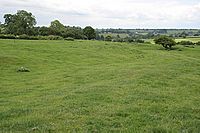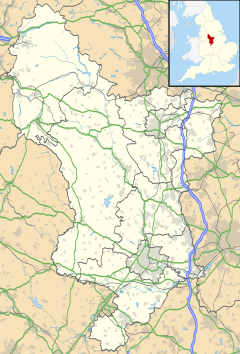Hungry Bentley facts for kids
Quick facts for kids Hungry Bentley |
|
|---|---|
 The former site of Hungry Bentley |
|
| OS grid reference | SK17873866 |
| Shire county | |
| Region | |
| Country | England |
| Sovereign state | United Kingdom |
| Post town | Ashbourne |
| Postcode district | DE6 |
| Police | Derbyshire |
| Fire | Derbyshire |
| Ambulance | East Midlands |
| EU Parliament | East Midlands |
Hungry Bentley is a fascinating place in Derbyshire, England. It's known as a deserted medieval village, which means it was once a busy community that people left a long time ago. You can find it between the towns of Uttoxeter and Derby.
This special site is protected as a scheduled monument. Experts even call it the best "depopulated settlement" in Derbyshire. The name Bentley likely means a clearing in the woods where a type of grass called bent grass grew. The unusual word "Hungry" was added because the land wasn't very good for farming, and the people living there often didn't have much food.
Contents
A Look Back in Time
Early Mentions
Hungry Bentley was first written about in the Domesday Book. This famous book was a big survey of England made in 1086 by William the Conqueror. At that time, the village belonged to a powerful person named Henry de Ferrers. The Domesday Book said the land was worth eleven shillings.
Back then, the place was just called Bentley. The word "Hungry" was added later. This helped people tell it apart from other villages named Bentley, like Fenny Bentley, which is quite close by.
Changing Owners
After the Ferrers family, different families owned Hungry Bentley. These included the Blounts, then Lord Mountjoy, and later the Browne family. Eventually, the Bentley family came to own the manor, which was the main estate.
One person, Edward Bentley, faced serious legal trouble in 1586. Later, in 1801, about 80 people lived in Hungry Bentley, in ten homes. Edward Wilmot bought the manor from the Bentley family. By 1817, it belonged to Sir Robert Wilmot. The main house, Bentley Hall, had become Bentley Hall Farmhouse.
By 1857, most of the manor was owned by Sir Sacheveral Wilmot. However, a small part of the land belonged to someone else. This small piece of land had been rented for 1,000 years back in 1686!
Why Did People Leave?
No one knows for sure why the people of Hungry Bentley left their village. It's a bit of a mystery! Some ideas include:
- The land wasn't good for farming.
- Farmers started focusing less on growing crops.
- The weather might have changed.
- The terrible disease known as the Black Death could have played a part.
In 1956, the site was officially recognized as a scheduled monument. This means it's a place of national importance, protected so we can learn from its past. Another similar deserted village, Wharram Percy in Yorkshire, is thought to have been abandoned for economic reasons.
What You Can See Today
Hungry Bentley is considered the best "depopulated settlement" in Derbyshire. If you visit the site, you can still see clear signs of where the main paths were. You can also spot where many of the old buildings once stood.
The most important building still standing is Bentley Hall. It lines up with where the old village paths would have been. It's also close to an ancient Roman road called Long Lane. This helps us imagine what the village looked like long ago.


